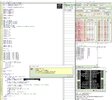x++ becomes x = x + 1
x += y becomes x = x + y
Single
& and
| or
are used in comparisons, like IF-THEN
Double && is logical AND, for bitwise results with numbers.
likewise || for logical OR
! is NOT
== is used in IF-THEN equal comparison, to distinguish it from x = y assignment.
x += y becomes x = x + y
Single
& and
| or
are used in comparisons, like IF-THEN
Double && is logical AND, for bitwise results with numbers.
likewise || for logical OR
! is NOT
== is used in IF-THEN equal comparison, to distinguish it from x = y assignment.


